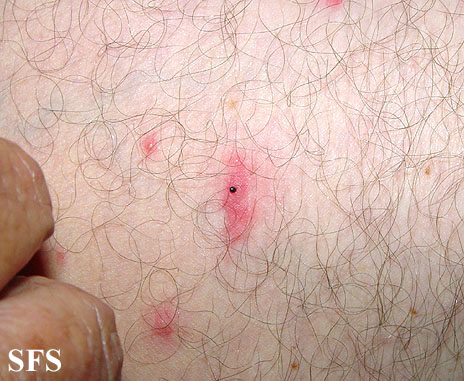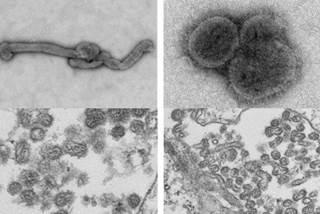Bourbon virus infection pathophysiology
|
Bourbon virus infection Microchapters |
|
Diagnosis |
|---|
|
Treatment |
|
Case Studies |
|
Bourbon virus infection pathophysiology On the Web |
|
American Roentgen Ray Society Images of Bourbon virus infection pathophysiology |
|
Risk calculators and risk factors for Bourbon virus infection pathophysiology |
Editor-In-Chief: C. Michael Gibson, M.S., M.D. [1]; Associate Editor(s)-in-Chief: Syed Hassan A. Kazmi BSc, MD [2]
Overview
Bourbon virus is a negative sense segmented RNA virus belonging to the genus Thogotovirus, family Orthomyxovirida. It is transmitted by insects and replicates in both arthropods and vertebrate hosts. The negative sense RNA virus replicates within the nuclei of the host cells. Thogoto virus Infection induces a sustained type 1 interferon response in the host until the adaptive immunity takes effect. Microscopically, bourbon viruses are 80-120nm in diameter with a genome size of approximately 10Kb.
Pathophysiology
Bourbon virus is a negative sense segmented RNA virus which belongs to the genus Thogotovirus, family Orthomyxovirida.
Transmission
- Bourbon virus is transmitted mainly by ticks, although other arthropods may also be involved in transmission.
- The virus is able to replicate in vertebrate and tick cells.
Adherence
- Virus attaches to the N-acetylneuraminic acid component found in host cell membrane (sialic acid receptors).[1]
Endocytosis
- The virus gets endocytosed by clathrins into the host cell.
- Endosome acidification induces fusion of virus membrane with the vesicle membrane.
Virology and replication
- Thogoto viruses differ from influenza virus in having capped viral mRNA without host messenger-derived heterogeneous sequences at the 5' end of the genome.[2][3]
- Five larger RNA segments each encode only one gene product, the sixth segment encodes two matrix proteins, M and ML.[4]
- Viral RNA polymerases (PA, PB1 and PB2) transcribe one mRNA from each genome segment.
- Splicing of segment 6 mRNA gives rise to mRNA coding for the matrix protein M1.[4]
- Transcription of genomic segments by the viral polymerase produces mRNAs that are capped and polyadenylated by the viral polymerase.
- The M1 protein is involved in export of genome from the nucleus.
- Assembly of the virus takes place in the cytoplasm from where new virions are released to infect other cells.
Host response
- Thogoto virus Infection induces a sustained type 1 interferon response in the host until the adaptive immunity takes effect.[5]
- IFN expression is mediated by specialized plasmacytoid dendritic cells (pDC).
- The interferon-induced dynamin-like MxA protein is involved in host antiviral activity against thogoto viruses.[6][7][8][9]
- MxA recognizes the nucleocapsids of invading viruses, causing an early block of the viral replication cycle.[6][10]
- Cytokines involved in the pathogenesis of bourbon virus infection are interleukin-1, interleukin-6, interleukin-10, macrophage inflammatory protein 1, monocyte chemoattractant protein (MCP)–1, and interferon (IFN).[11]
Genetics
Associated conditions
Few rare conditions associated with bourbon virus infection are: [12]
Gross Pathology
Rash may be the first sign of infection.
- The rash of Bourbon virus infection is usually circular and located at the site of the tick bite.
Microscopic Pathology
- Thogoto viruses are spherical, enveloped single stranded RNA viruses with a segmented genome.
- Virions are 80-120nm in diameter with a genome size of approximately 10Kb.
- The 6-7 segments of genome encodes for 7-9 proteins with each segment size ranging from a low of 0.9Kb to 2.3Kb.
References
- ↑ "Receptor-Mediated Endocytosis and the Sorting of Internalized Proteins - Molecular Cell Biology - NCBI Bookshelf".
- ↑ "www.ncbi.nlm.nih.gov" (PDF).
- ↑ Albo C, Martín J, Portela A (1996). "The 5' ends of Thogoto virus (Orthomyxoviridae) mRNAs are homogeneous in both length and sequence". J. Virol. 70 (12): 9013–7. PMC 191002. PMID 8971034.
- ↑ 4.0 4.1 "Microbiology Society Journals | Functional comparison of the two gene products of Thogoto virus segment 6".
- ↑ Kochs G, Bauer S, Vogt C, Frenz T, Tschopp J, Kalinke U, Waibler Z (2010). "Thogoto virus infection induces sustained type I interferon responses that depend on RIG-I-like helicase signaling of conventional dendritic cells". J. Virol. 84 (23): 12344–50. doi:10.1128/JVI.00931-10. PMC 2976394. PMID 20861272.
- ↑ 6.0 6.1 Patzina C, Haller O, Kochs G (2014). "Structural requirements for the antiviral activity of the human MxA protein against Thogoto and influenza A virus". J. Biol. Chem. 289 (9): 6020–7. doi:10.1074/jbc.M113.543892. PMC 3937669. PMID 24448803.
- ↑ Haller O, Kochs G (2011). "Human MxA protein: an interferon-induced dynamin-like GTPase with broad antiviral activity". J. Interferon Cytokine Res. 31 (1): 79–87. doi:10.1089/jir.2010.0076. PMID 21166595.
- ↑ Frese M, Kochs G, Meier-Dieter U, Siebler J, Haller O (1995). "Human MxA protein inhibits tick-borne Thogoto virus but not Dhori virus". J. Virol. 69 (6): 3904–9. PMC 189115. PMID 7745744.
- ↑ Pringle CR (1996). "Virus taxonomy 1996 - a bulletin from the Xth International Congress of Virology in Jerusalem". Arch. Virol. 141 (11): 2251–6. PMID 8992952.
- ↑ Pavlovic J, Haller O, Staeheli P (1992). "Human and mouse Mx proteins inhibit different steps of the influenza virus multiplication cycle". J. Virol. 66 (4): 2564–9. PMC 289059. PMID 1548781.
- ↑ "The Interferon Antagonist ML Protein of Thogoto Virus Targets General Transcription Factor IIB".
- ↑ Kosoy OI, Lambert AJ, Hawkinson DJ, Pastula DM, Goldsmith CS, Hunt DC, Staples JE (2015). "Novel thogotovirus associated with febrile illness and death, United States, 2014". Emerging Infect. Dis. 21 (5): 760–4. doi:10.3201/eid2105.150150. PMC 4412252. PMID 25899080.


